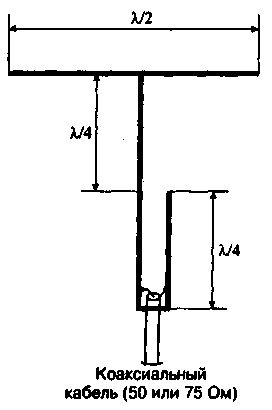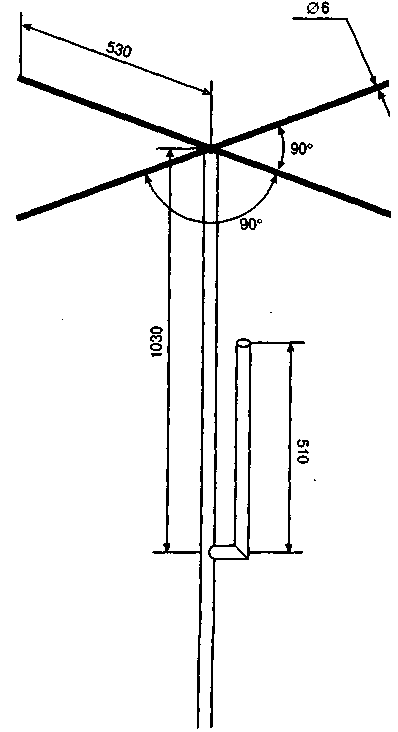
|
|
ENCYCLOPEDIA OF RADIO ELECTRONICS AND ELECTRICAL ENGINEERING Antenna UT5VD for 2-meter range with a circular pattern in two planes. Encyclopedia of radio electronics and electrical engineering
Encyclopedia of radio electronics and electrical engineering / HF antennas In recent years, the interest of radio amateurs in the 2-meter range has been constantly growing due to the increase in the number of FM repeaters and, accordingly, the improvement of conditions for the development of mobile communications, a network of various BBS and portals, incl. with Internet access, as well as satellite transponders. The increase in activity is also facilitated by the permission from March 1, 1998 to work on VHF for beginner radio amateurs. When working on the 2-meter band, antennas are used both with vertical polarization (mainly for mobile communications and when working through repeaters), and with horizontal polarization. In this case, it is desirable to have an antenna with a circular radiation pattern in both horizontal and vertical planes. The latter is very important when working through satellite (IC3) transponders. For these purposes, as a rule, several antennas are used, which reduces the efficiency in operation under the condition of long-range unstable transmission on the 2-meter range. The author managed to solve this problem by implementing an antenna with a practically spherical radiation pattern. In this case, the antenna can radiate and, accordingly, receive electromagnetic waves with both vertical and horizontal polarization. The basis of the design is the popular J-antenna (Fig. 1). It is a vertical dipole fed from the lower end with a short-circuited quarter-wave line. As is known [1], this antenna operates only with vertical polarization and has a circular pattern in the horizontal plane with a deep minimum in the vertical direction.
The author proposed to change the shape of the vertical radiator of this antenna by bending the dipole in half at 90°. In this case, the horizontal part of the dipole in the first version consisted of two opposite elements of length L / l each (Fig. 2) and was first described in the collection "Infoix" No. 4/1990, pp. 42,43.
In the latest modification, the author proposed to make the horizontal part of the emitter from 4 mutually perpendicular segments of length l/4, which have electrical contact with the vertical part of the emitter (Fig. 32). The design of the antenna is simple to manufacture and easy to repeat even for novice radio amateurs. The vertical parts of the antenna are made of a pipe with a diameter of 6 mm. Material - bronze, brass, copper, as well as aluminum alloys, provided that reliable electrical contact is ensured between all parts of the antenna and the matching device (soldering or welding). The horizontal cross-shaped part is made of a rod or a tube with a diameter of 32 mm (the material is similar to the used pipe with a diameter of XNUMX mm).
This design retains the advantage of the J-antenna in that the lower end of the short-circuited quarter-wave line can be grounded, eg electrically connected to a grounded mast, in which case the entire antenna can serve as a good lightning conductor. The setting consists in selecting the place for connecting the power cable to the matching line (Fig. 4) according to the minimum SWR. The author used RK-75. but you can also use a feeder with a characteristic impedance of 50 ohms. With the dimensions indicated in Fig. 3, 4 and a 75-ohm feeder, SWR \u1,0d 145,5 near XNUMX MHz.
The antenna is mounted on a metal grounded mast, at a height of 7 m above the ground, but a mast of any material and design can be used. Foreign conductive objects must be removed from horizontal elements by more than 2 meters. With a corresponding change in geometric dimensions, such an antenna can also be built for other VHF bands. This antenna has been working for the author since 1983. She showed good results with all types of transmission, as well as with contacts through amateur IC3 in their visibility zone and without signal failure "overhead". During Field Day 2000, an experiment was conducted on the basis of UT0H, during which the signals of my beacon, which used the described antenna, were received on antennas with both vertical and horizontal polarizations with approximately the same loudness. From the editorial board. Figures 1 and 4 show two options for connecting a cable to a matching line. In the first case (Fig. 1), the central core is soldered to the line conductor connected to the emitter, and in the author's version (Fig. 4), vice versa. Both options are equivalent, although in the publication "the method of connecting the cable shown in Fig. 1 is more common. Literature 1. Benkovsky 3., Lipinsky E. Amateur antennas of short and ultrashort waves: Per. from Polish / Ed. O. P. Frolova. - M.: Radio and communication, 1983. 480 p., ill. - (Mass Radio Library; Issue 1052). Author: Anatoly Kalashnik (UT5VD), Protopopovka village, Alexandrovsky district, Kirovograd region; Publication: N. Bolshakov, rf.atnn.ru
Machine for thinning flowers in gardens
02.05.2024 Advanced Infrared Microscope
02.05.2024 Air trap for insects
01.05.2024
▪ 500 megapixel face control camera ▪ Non-contact emotion recognition system ▪ At 80, old age is just beginning. ▪ Cree XLamp XH Efficient Ceramic LEDs
▪ section of the site Microcontrollers. Article selection ▪ article Strangers do not go here. Popular expression ▪ How do deaf schizophrenics hear voices? Detailed answer ▪ article Kamchatka Peninsula. Nature miracle
Comments on the article: Vladimir Thank you very much for the information on this antenna.
Home page | Library | Articles | Website map | Site Reviews www.diagram.com.ua |






 Arabic
Arabic Bengali
Bengali Chinese
Chinese English
English French
French German
German Hebrew
Hebrew Hindi
Hindi Italian
Italian Japanese
Japanese Korean
Korean Malay
Malay Polish
Polish Portuguese
Portuguese Spanish
Spanish Turkish
Turkish Ukrainian
Ukrainian Vietnamese
Vietnamese




 Leave your comment on this article:
Leave your comment on this article: